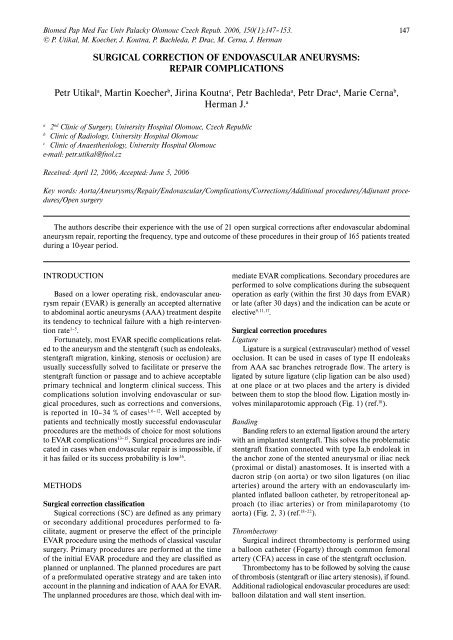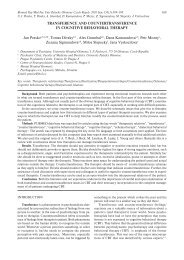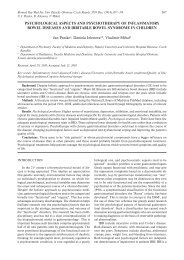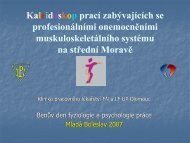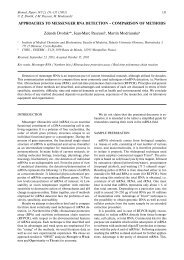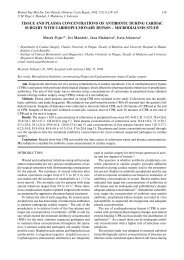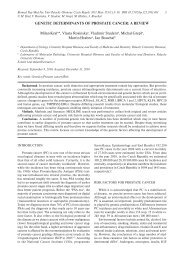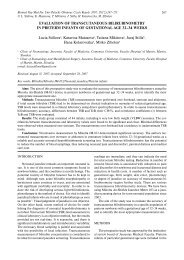SURGICAL CORRECTION OF ENDOVASCULAR ANEURYSMS ...
SURGICAL CORRECTION OF ENDOVASCULAR ANEURYSMS ...
SURGICAL CORRECTION OF ENDOVASCULAR ANEURYSMS ...
Create successful ePaper yourself
Turn your PDF publications into a flip-book with our unique Google optimized e-Paper software.
Biomed Pap Med Fac Univ Palacky Olomouc Czech Repub. 2006, 150(1):147–153.© P. Utikal, M. Koecher, J. Koutna, P. Bachleda, P. Drac, M. Cerna, J. Herman147<strong>SURGICAL</strong> <strong>CORRECTION</strong> <strong>OF</strong> <strong>ENDOVASCULAR</strong> <strong>ANEURYSMS</strong>:REPAIR COMPLICATIONSPetr Utikal a , Martin Koecher b , Jirina Koutna c , Petr Bachleda a , Petr Drac a , Marie Cerna b ,Herman J. aa2 nd Clinic of Surgery, University Hospital Olomouc, Czech RepublicbClinic of Radiology, University Hospital OlomouccClinic of Anaesthesiology, University Hospital Olomouce-mail: petr.utikal@fnol.czReceived: April 12, 2006; Accepted: June 5, 2006Key words: Aorta/Aneurysms/Repair/Endovascular/Complications/Corrections/Additional procedures/Adjuvant procedures/OpensurgeryThe authors describe their experience with the use of 21 open surgical corrections after endovascular abdominalaneurysm repair, reporting the frequency, type and outcome of these procedures in their group of 165 patients treatedduring a 10-year period.INTRODUCTIONBased on a lower operating risk, endovascular aneurysmrepair (EVAR) is generally an accepted alternativeto abdominal aortic aneurysms (AAA) treatment despiteits tendency to technical failure with a high re-interventionrate 1–5 .Fortunately, most EVAR specific complications relatedto the aneurysm and the stentgraft (such as endoleaks,stentgraft migration, kinking, stenosis or occlusion) areusually successfully solved to facilitate or preserve thestentgraft function or passage and to achieve acceptableprimary technical and longterm clinical success. Thiscomplications solution involving endovascular or surgicalprocedures, such as corrections and conversions,is reported in 10–34 % of cases 1, 6–12 . Well accepted bypatients and technically mostly successful endovascularprocedures are the methods of choice for most solutionsto EVAR complications 13–15 . Surgical procedures are indicatedin cases when endovascular repair is impossible, ifit has failed or its success probability is low 16 .METHODSSurgical correction classificationSugical corrections (SC) are defined as any primaryor secondary additional procedures performed to facilitate,augment or preserve the effect of the principleEVAR procedure using the methods of classical vascularsurgery. Primary procedures are performed at the timeof the initial EVAR procedure and they are classified asplanned or unplanned. The planned procedures are partof a preformulated operative strategy and are taken intoaccount in the planning and indication of AAA for EVAR.The unplanned procedures are those, which deal with immediateEVAR complications. Secondary procedures areperformed to solve complications during the subsequentoperation as early (within the first 30 days from EVAR)or late (after 30 days) and the indication can be acute orelective 9, 11, 17 .Surgical correction proceduresLigatureLigature is a surgical (extravascular) method of vesselocclusion. It can be used in cases of type II endoleaksfrom AAA sac branches retrograde flow. The artery isligated by suture ligature (clip ligation can be also used)at one place or at two places and the artery is dividedbetween them to stop the blood flow. Ligation mostly involvesminilaparotomic approach (Fig. 1) (ref. 18 ).BandingBanding refers to an external ligation around the arterywith an implanted stentgraft. This solves the problematicstentgraft fixation connected with type Ia,b endoleak inthe anchor zone of the stented aneurysmal or iliac neck(proximal or distal) anastomoses. It is inserted with adacron strip (on aorta) or two silon ligatures (on iliacarteries) around the artery with an endovascularly implantedinflated balloon catheter, by retroperitoneal approach(to iliac arteries) or from minilaparotomy (toaorta) (Fig. 2, 3) (ref. 18–22 ).ThrombectomySurgical indirect thrombectomy is performed usinga balloon catheter (Fogarty) through common femoralartery (CFA) access in case of the stentgraft occlusion.Thrombectomy has to be followed by solving the causeof thrombosis (stentgraft or iliac artery stenosis), if found.Additional radiological endovascular procedures are used:balloon dilatation and wall stent insertion.
148 P. Utikal, M. Koecher, J. Koutna, P. Bachleda, P. Drac, M. Cerna, J. HermanCADBEAFig. 1. 55-year-old male with EVAR by aortouniiliac stentgraft.Type IIa endoleak attributed to retrograde flow in IMA, successfullytreated by ligature 20 months after primary procedure.A: CTA transverse section of aneurysmal sac with stentgraft and endoleak.B: Selective DSA of superior mesenteric artery shows retrograde IMAfilling as the cause of endoleakC, D, E: AAA sac with IMA approached by minilaparotomy. Theartery is divided between two ligatures.Endarterectomy, patch plasticWhere stentgraft thrombosis is caused by severe CFAatherosclerotic changes (AS), direct surgical endarterectomywith ePTFE patch plastic is indicated.Femoral-femoral crossover bypassFemoral-femoral crossover bypass is performed for extraanatomicallimb revascularisation in case of iliac occlusionon one side. Dacron prosthesis (diameter 7 or 8)is anastomosed by prosthesis end to the side of commonfemoral artery (CFA) on both sides and using a tunnellerit is subcutaneously placed in the suprapubic region(Fig. 4).In this paper we describe our experience in primaryunplanned or secondary surgical corrections of EVARcomplications performed to prevent sac rupture or tosolve limb ischaemia. Surgical corrections connected withEVAR access site were not incorporated into this study.PATIENTS, RESULTSBetween 1996 and 2005, we treated endovascularly165 patients with asymptomatic AAA. One type of stentgraftsystem: Ella (ELLA CS, Hradec Králové, CzechRepublic) was used for AAA exclusion in all patients.Stentgraft configuration included 3 aortic tubes, 136 bifurcatedgrafts, and 26 aortouniiliac grafts. In 7 (4.2 %) patientsimmediate, early or late conversion to open surgerywas necessary. On the other hand, in 38 (23 %) patients,a total of 51 immediate, early and late endovascular cor-
Surgical correction of endovascular aneurysms: Repair complications149ABCDEFig. 2. 65–year-old male with EVAR by aortouniiliac stentgraft.Type Ia endoleak attributed to failed stentgraft sealing in proximal aortic neck,successfully treated by banding.A: Post primary procedure DSA shows type Ia aortic endoleakB, C: Drawing of type Ia endoleak and its correction by proximal neck bandingD: DSA after successful correction without signs of type Ia endoleakE: Peroperative view of proximal aortic neck banding approached by minilaparotomyrections (n = 15), endovascular conversions (n = 2) andsurgical corrections (n = 34) were successfully used, andthe primary technical success of 93.9%, primary assistedtechnical success of 98.8 % and secondary clinical successof 95.7 %. were achieved 23-26 . The 34 surgical correctionsrepresenting 67 % of the total corrections were performedimmediately (n = 4), during the first next 30 days (n = 10),and during the follow up period (min 1 month, max 120months) (n = 20) in 21 patients. The endoleak corrections(n = 7 21 %) were performed immediately (n = 2) and electively(n = 5) in 7 patients. Ligature of inferior mesentericartery (IMA) (n = 2) was electively in hemodynamicallysignificant type II endoleak used (Fig. 1). Proximal aorticbanding (n = 4) was performed immediately in primarytype Ia endoleak (n = 2) and electively in the secondaryone (n = 2) (Fig. 2). Distal iliac banding (n = 1) was performedelectively in persistent distal iliac type Ib endoleak(Fig. 3). All the surgical corrections due to stentgraftthrombosis (n = 27 79 %) in 14 patients were performedacutely. We performed surgical thrombectomy (n = 18)(one or two times repeated in 4 patients) followed by commonfemoral endarterectomy with patch plastic (n = 5)and external iliac artery straightening (n = 1) and femoral-femoralcross over bypass (n = 3) to solve the causeof thrombosis (Fig. 4). The procedures were performedunder regional (spinal or epidural) (n = 27) or general(n = 7) anesthesia. All the surgical corrections were fullytechnically and clinically successful and all of the femoral-femoralcrossover bypasses remain primarily patent.There was no death and no severe morbidity (cardiac orpulmonary) following surgical corrections.DISCUSSIONEndovascular correction or conversion is determinedto be the method of choice for most EVAR complicationsrepair 7, 9, 11–15 . The concept of having a „tool-box“ con-
150 P. Utikal, M. Koecher, J. Koutna, P. Bachleda, P. Drac, M. Cerna, J. HermanABCDFig. 3. 75-year-old male with EVAR by aortouniiliac stentgraft.Type Ib endoleak attributed to failed stentgraft sealing in thedistal iliac neck, successfully treated by banding.A: Post primary procedure DSA shows type Ib iliac endoleakB: Drawing of the type Ib iliac endoleakC: Drawing of distal iliac bandingD: Peroperative view of retroperitoneally approached distaliliac bandingtaining a variety of devices for endovascular correctionsmakes this method even more attractive 27 . Surgical repairis thus indicated where endovascular repair is impossibleor where it has failed 16 . Some reports present more frequentlysurgical procedures (as the technically easier option)used for complications solution early in their EVARexperience in contrast to later periods 9 . We preferred endovascularcorrection or conversion procedures, which,when indicated were mostly successful 23–26 . Nevertheless,we do not hesitate to apply surgical correction where itis deemed useful 18, 21 . Most elective re-interventions aredue to endoleak. The majority of acute re-interventionsare required due to stentgraft thrombosis with acute limbischaemia 7, 9, 11, 14–15 .Our experience with EVAR complications requiringintervention is comparable with other presented reports.Type I endoleaks, especially the late proximal ones, areabsolutely indicated for repair, and this was also the casein our patients 27–28 . In our early experience, immediatetype Ia endoleaks in our patients were caused by failedstentgraft placement in the short conical neck. Secondarytype Ia endoleaks developed 6 and 8 months after EVARcaused by failed stentgraft sealing in the short conicalproximal neck of large diameter (30mm) as a late resultof primary morphological indication mistake (Fig. 2).Iliac distal endoleak that occurred 6 months after EVARwas caused by non-matching stentgraft and common iliacartery diameters resulting from incorrect measurementagain (Fig. 3).In agreement with other authors, our managementstrategy for type II endoleak is conservative, and repair isindicated in case of hemodynamic importance with highflow and an increase in aneurysm size 27-28 . There were14 (8.8 %) secondary type II endoleaks observed in our
Surgical correction of endovascular aneurysms: Repair complications151ABFig. 4. 65–year-old female with EVAR by bifurcated stentgraftThe lower extremity revascularisation using femoral-femoralcross over bypass in case of bifurcated stentgraft one limbirreparable thrombosisA: Drawing of extraanatomical revascularisation by femoralfemoralbypassB: DSA of femoral- femoral bypasspatients but only 2 (1.3 %) of hemodynamic significance(both attributed to retrograde flow in IMA) were repaired11(n = 1) and 20 (n = 1) months after the EVAR (Fig. 1).The incidence of stentgraft thrombosis varies about 2 %and occurred almost exclusively in only one limb of bifurcatedgrafts. Stentgraft or iliac-femoral artery regionstenoses are frequent causes. Stentgraft stenosis is mostlycaused by stentgraft kinking or twisting in an angulatedaneurysmal sac and in the iliac artery or by its compressionin a narrow distal aneurysmal sac when a bifurcatedgraft is used. They all result from a primary less suitableaneurysmal morphology or its secondary changes over thetime. Paradoxically, reduction in aneurysmal sac size aftersuccessful EVAR may lead to kinking, with progressionto thrombosis 27, 29 . Iliac-femoral artery stenosis is mostlycaused by progression of AS changes in this location.There was critical limb ischemia (n = 6) in patients withsevere comcomitant atherosclerotic changes in femoropoplitealand crural region. The thrombosis involved aniliac limb of a bifurcated stentgraft (n = 9), the whole bifurcatedstentgtaft (n = 2) and the aortouniiliac (n = 3) one.The causes include bifurcated stentgraft limb compressiondue to narrow distal aneurysmal sac diameters (n = 3),stentgraft kinking (n = 3), damaged iliac -femoral arteryaccess site (n = 3), kinked external iliac artery (n = 1), iliacartery AS changes progression (n = 2) and hyperkoagulativestate (n = 2).All the classical vascular surgical procedures performedin our patients for EVAR corrections were verypracticable and technically sucessful. Regional anesthesiawas preferred when the inguinal or retroperitoneal approachwas used, while general anesthesia was appliedin case of transperitoneal approach. We did not use thelaparoscopic approach for clip ligation or banding. It is aless invasive procedure, but not one involving less stress,especially in high-risk patients.In stentgraft thrombosis, we did not use thrombolysis.Surgical thrombectomy is more feasible in this aortoiliacregion.No ilicofemoral bypass was necessary to solve thecause of thrombosis. Stenosed iliac limb (n = 2) and iliacartery (n = 3) were solved using surgical thrombectomyfollowed by balloon dilatation supported by wall-stent insertion(n = 2). Femoral-femoral bypass is recommendedas the last but often is the most simple and useful revascularisationoption in one limb of bifurcated stentgraftthrombosis, especially when it is caused by problems withthe stentgraft itself.It is a hemodynamically less stressful and well-acceptedtype of revascularisation (Fig. 4). Surgical correctionsare generally more invasive, especially when extensive approach(retroperitoneal or transperitoneal) is required,but they still involve less hemodynamic stress Multi-centrestudies report significantly higher morbidity and mortalityrates when the procedures of surgical correction wereperformed 12, 30 . Our single-centre experience producesmore favourable results. All the used surgical procedureswere well tolerated by the patients and there was no severemorbidity related to the greater invasivenes. Accordingto our current follow-up protocol, angiography (DSA)is performed on the tenth postoperative day, computedtomography angiography (CTA) and plane abdominal
152 P. Utikal, M. Koecher, J. Koutna, P. Bachleda, P. Drac, M. Cerna, J. HermanX-ray are performed annually after it. Based on our 10-year experience, we considered this follow-up screeningsufficient 25, 31 . Regular and thorough follow-up after EVARis important to identify possible complications at an earlystage. At this initial stage, the repair would mostly be technicallyeasy and of a preventive nature to avoid later life orlimb threatening complications. In order to determine theexact cause of complications, conventional angiography(DSA) is mostly indicated. Different re-intervention ratesare reported for different stentgraft configurations andtypes. Given the current improvements in the availabilityof different stentgraft types, it is possible to select one of aquality corresponding with the aorto-iliac anatomy to preventcomplications and re-interventions 11 . The bifurcatedstentgraft configuration and the Ella (ELLA CS, HradecKrálové, Czech Republic) stentgraft system, which weused in all AAA exclusions, contributed well to the acceptablere-intervention rate in our series 23–25 . The factthat more re-interventions after EVAR were required inhigh-risk patients (ASA IV) with AAA of complex morphologyis a result of extreme EVAR indication in thesepatients who were unsuitable for open AAA surgery. Insuch cases, EVAR re-interventions involve a significantlyhigh risk, especially at later complications stages. Therewere three such problematic patients who required surgicalcorrection in our group.Therefore, when extreme AAA morphological indicationis necessary (in elderly high risk patients withlarge AAA), using a combination of EVAR and primaryplanned procedures of surgical correction (combinedstrategy) is recommended to facilitate the principle procedureand to prevent complications 12, 17–18, 21–22, 32–34 .CONCLUSIONAccording to our experience with surgical correctionsand the results, we can confirm it to be useful for therepair of some EVAR complications and recommendedas an adequate option; easy and quick to perform, andreliable and safe, despite its invasiveness.REFERENCES1. Laheij RJF, Buth J, Harris PL, Moll FL, Stelter WJ, VerhoevenELG. (2000) Need for secondary interventions after endovascularrepair of abdominal aortic aneurysms. Intermediate-term follow-upresults of a European collaborative registry EUROSTAR). Br J Surg87, 1666–1673.2. Ohki T, Veith FJ, Shaw P, Lipsitz E, Suggs WD, Wain RA. (2001)Increasing incidence of midterm and long-term complications afterendovascular graft repair of abdominal aortic aneurysms: a note ofcaution based on a 9-year experience. Ann Surg 234, 323–334.3. Cao P, Verzini F, Parlani G, Romano L, De Rango P, Pagliuca V.(2004) Clinical effect of abdominal aortic aneurysm endografting:7-year concurent comparison with open repair. J Vasc Surg 40,841–848.4. EVAR Trial participants. Endovascular aneurysm repair versusopen repair in patients with abdominal aortic aneurysm (EVARtrial 1): randomised controlled trial. (2005) Lancet 365, 2179–2186.5. Blankenstein JD, de Jong SE, Prinssen M, van der Ham AC, ButhJ, van Sterkenburg SM. (2005) Two-years outcomes after conventionalor endovascular repair of abdominal aortic aneurysms.NEngl J Med 352, 2398–2405.6. May J, White GH, Waugh R, Petrasek P, Chaufour X, ArulchelvamM, Stephen MS, Harris JP. ( 2000) Life-table analysis of primaryand assisted success following endoluminal repair of abdominalaortic aneurysm: the role of supplementary endovascular interventionin improving outcome. Eur J Vasc Endovasc Surg 19,648–655.7. Datillo J, Brewster DC, Fan CM, Celler SC, Cambria RP,Lamuraglia GM. (2002) Clinical failures of endovascular abdominalaortic aneurysm repair: incidence, causes, and management. JVasc Surg 35(6), 1137–1147.8. Sampram ES, Karafa MT, Mascha EJ, Clair DG, Greenberg RK,Lyden SP, O’Hara PJ, Sarac TP, Srivastava SD, Butler B, Ouriel K.(2003) Nature, frequency and predictors of secondary proceduresafter endovascular repair of abdominal aortic aneurysm. J VascSurg 37, 930–937.9. Flora HS, Chaloner EJ, Sweeney A, Brookes J, Raphael MJ,Adiseshiah M. (2003) Secondary intervention following endovascularrepair of abdominal aortic aneurysm: a single centre experience.Eur J Vasc Endovasc Surg 26, 287–292.10. Bequemnin JP, Kelley L, Zubilewicz T, Desgranges P, LapeyereM, Kobeiter H. (2004) Outcomes of secondary interventions afterabdominal aortic aneurysm endovascular repair. J Vasc Surg 39,298–305.11. Verhoeven ELG, Tielliu IFJ, Prins TR, Zeebregts CJAM, vanAndringa de Kempenaer MG, Cina CS, van den Dungen JJAM.(2004) Frequency and outcome of re-interventions after endovascularrepair for abdominal aortic aneurysm: a prospective cohortstudy. Eur J Vasc Endovasc Surg 28, 357–364.12. Hobo R, vanMarrewijk CJ, Leurs LJ, Laheij RJF, Buth J on behalfof the EUROSTAR collaborators. (2005) Adjuvant procedures performedduring endovascular repair of abdominal aortic aneurysm.Does it influence outcome? Eur J vasc Endovasc Surg 30, 20-28.13. Ivancev K, Chuter T, Lindh M, Lindbladt B, Brunkwall J, RisbergB. (1996) Options for treatment of persistent aneurysm perfusionafter endovascular repair. World J Surg 20, 673–678.14. Dorffner R, Thurnher S, Polterauer P, Kretschmer G, Lammer J.(1997) Treatment of abdominal aortic aneurysms with transfemoralplacement of stentgrafts: complications and secondary radiologicintervention. Radiology 204, 79–86.15. Tibballs JM, van Schie G P, Sieunarine K, Lawrence-Brown MMD,Hartley D, Goodman MA, Prendergast FJ. (1998) Endovascularconversion procedure for failed primary endovascular aortic stentgrafts.Cardiovasc Intervent Radiol 21, 79–83.16. May J, White GH, Yu W. (1995) Surgical management of complicationsfollowing endoluminal grafting of abdominal aortic aneurysm.Eur J Vasc Endovasc Surg 10, 51–59.17. Chaikoff EL, Blankenstein JD, Harris PL, White GH, ZarinsChK, Bernhard VM, Matsumura JS, May J, Veith FJ, FillingerMF, Rutherford RB, Kent KG, for the Ad Hoc Committee forStandardized Reporting Practices in Vascular Surgery of theSociety for Vascular Surgery/American Association for VascularSurgery. (2002) Reporting standards for endovascular aortic aneurysmrepair. J Vasc Surg, 35, 1048–1060.18. Utíkal P, Köcher M, Bachleda P, Dráč P, Buriánková E, KojeckýZ, Ürge J. (2001) Léčba AAA na přelomu tisíciletí – stentgrafting– role cévního chirurga. Prakt Flebol 10, 111–113.19. Hölzenbein TJ, Kretschmer G, Dorffner R, Thurnher S, SandnerD, Minar E, Lammer J, Polterauer P. (1998) Endovascular managementof „Endoleaks“ after transluminal infrarenal abdominalaneurysm repair. Eur J Vasc Endovasc Surg 16, 208–217.20. Sonesson B, Montgomery A, Ivancev K, Lindblad B. (2001)Fixation of infrarenal aortic stent-grafts using laparoscopic bandiganexperimental study in pigs. Eur J Vasc Endovas Surg 21, 40–45.21. Utíkal P, Köcher M, Bachleda P, Dráč P, Černá M, Buriánková E.(2004) Banding in aortic stent-graft fixation in EVAR. Biomed PapMed Fac Univ Palacky Olomouc 148,175–178.
Surgical correction of endovascular aneurysms: Repair complications15322. Utíkal P, Köcher M, Koutná J, Bachleda P, Dráč P, Černá M,Buriánková E, Herman J. (2005) Combined strategy in AAA electivetreatment. Biomed Pap Med Fac Univ Palacky Olomouc 149,159–163.23. Utíkal P, Köcher M, Bachleda P, Novotný J, Ürge J, Dráč P. (2000)Tříleté zkušenosti stentgraftingem AAA ve FN UP v Olomouci.Prakt Flebol 9,175–179.24. Köcher M, Utíkal P, Buriánková E, Koutná J, Bachleda P, |NovotnýJ, Heřman M, Benýšek V, Bučil J, Černá M. (2001) Čtyřletézkušenosti se stentgraftem ELLA v endovaskulární léčbě AAA.Čes Radiol 55, 159–166.25. Köcher M, Utíkal P, Koutná J, Bachleda P, Buriánková E, HeřmanM, Bučil J, Benýšek V, Černá M, Kojecký Z. (2004) Endovasculartreatment of abdominal aortic aneurysms-6 years of experiencewith Ella stent-graft system. Eur J of Radiol 51, 181–188.26. Köcher M, Utíkal P, Bachleda P, Novotný J. (2001) Endovascularconversion – the possible solution of intersegmental endoleak inpatient with AAA treated by bifurcated type of stentgraft. Eur JVasc Endovasc Surg, Extra – online version.27. White G H, May J, Petrasek P. (2000) Specific complications ofendovascular aortic repair. Semin Intervent Cardiol 5, 35–4628. vanMarrewijk C, Buth J, Harris PL, Norgren L, Nevelsteen A, WyatMG. (2002) Significance of endoleaks after endovascular repair ofabdominal aortic aneurysms: The EUROSTAR experience. J VascSurg 34, 461–473.29. Boyle JR, Thompson MM, Clode-Baker EG. (1998) Torsion andkinking of unsupported aortic stentgrafts: Treatment by endovascularintervention. J Endovasc Surg 5, 216–22130. Lee WA, Berceli SA, Huber TS, Ozaki CK, Flyn TC, Seeger JM.(2003) Morbidity with retroperitoneal procedures during ednovasculatabdominal aortic aneurysm repair. J Vasc Surg 38, 459-463.31. Černá M, Köcher M, Utíkal P, Benýšek V, Bučil J, Heřman M,Bachleda P, Koutná J. (2005) Úprava protokolu sledování nemocnýchpo endovaskulární léčbě aneuryzmatu abdominální aorty nazákladě retrospektivní analýzy vývoje velikosti vaku aneuryzmatua výskytu endoleaků. Čes Radiol 59,153–161.32. May J, White GH, Yu W, Waugh RC, Stephen MS. Harris JP.(1996) Results of endoluminal grafting of abdominal aortic aneurysmsare dependent on aneurysm morphology. Ann Vasc Surg 10,254–261.33. Yano OJ, Faries PL, Morrisey N, Teodorescu V, Hollier LH, MarinML. (2001) Ancillary techniques to facilitate endovascular repairof aortic aneurysms. J Vasc Surg 34, 69–75.34. Greenberg RK, Clair D, Srivastava S, Bhandari G, Turc A,Hampton J. (2003) Should patients with challenging anatomy beoffered endovascular aneurysm repair? J Vasc Surg 38, 990–996.


